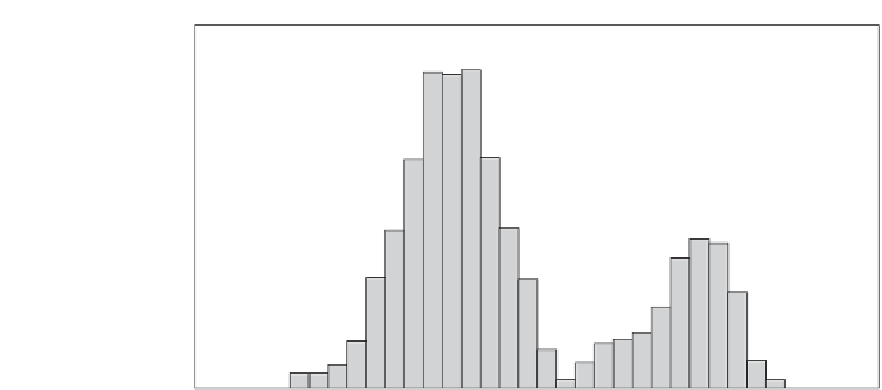Geoscience Reference
In-Depth Information
140
120
C3 plants
(broad-leaved)
100
80
C4 plants
(grass)
60
40
20
0
−
40
−
35
−
30
−
25
−
20
−
15
−
10
−
5
δ
13
C
Figure 3.10
The effect of the metabolic cycle on the fractionation of carbon isotopes during photosynthesis.
The C3 cycle (broad-leaved plants) and C4 cycle (grasses) correspond to very different
photosynthetic processes within the cell. Past climatic conditions can therefore be inferred from
the
13
C value of organic remains (Deines,
1980
).
δ
strongly than heavy isotopes. In particular for fast reaction rates, equilibrium is therefore
not necessarily achieved. Thus, by comparison with the environment within which they
formed, organic products are significantly depleted in
13
C relative to
12
C. Such isotopic
effects are extensively used in studying the genesis of fossil fuels and low-temperature
mineralization in which biological processes are important, and in fingerprinting traces of
early life in Archean sediments.
Since the isotopic standard of this element is the PDB marine carbonate, marine car-
bonates, as a whole, have
13
C values close to 0
δ
. The carbon in atmospheric CO
2
has
13
C value close to
a
δ
−
7
. The continental biomass (dominated by plants), in contrast,
13
C values. The distribution has two maxima, one at about
has very negative
δ
−
14
,
corresponding generally to grasses, and a larger one at about
, corresponding to
tosynthesis does not take place at equilibrium. It is brought about by two different CO
2
fixation mechanisms by very different plants, with what are known as the C4 pathway,
predominating for grasses, and the C3 pathway, for broad-leaved plants and conifers.
The very negative values of the C3 plants are essentially due to intracellular kinetic
fractionation during C fixation mediated by the enzyme known as “rubisco.” The varia-
tion in
−
25
13
C of fossil plant matter collected from bores in peat bogs is thus utilized for
tracing changes in vegetation between glacial and interglacial periods. Increased
δ
13
Clev-
els of organic matter are interpreted as marking the advance of grasslands, while very
negative
δ
13
C levels indicate a return of broad-leaved plants. The
13
Cof
δ
δ
≈−
25
of bitumen is inherited from their vegetal precursors. Carbon in oil tends to be even
lighter.
















































